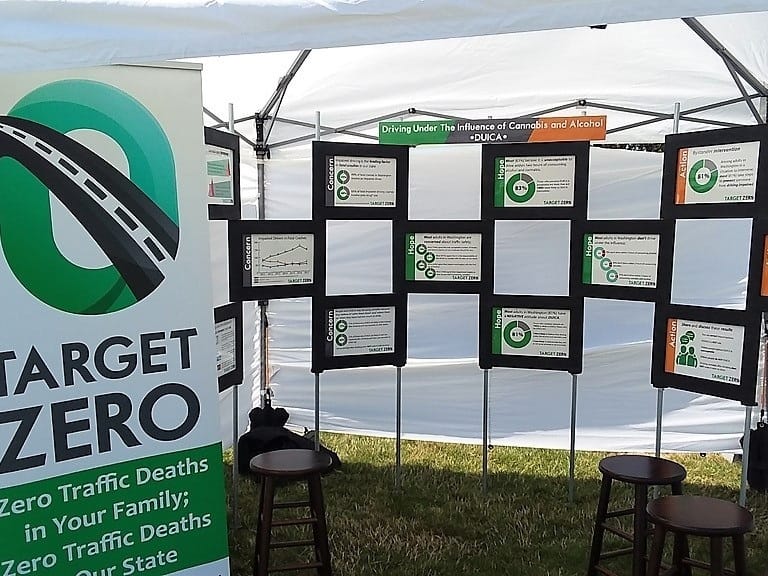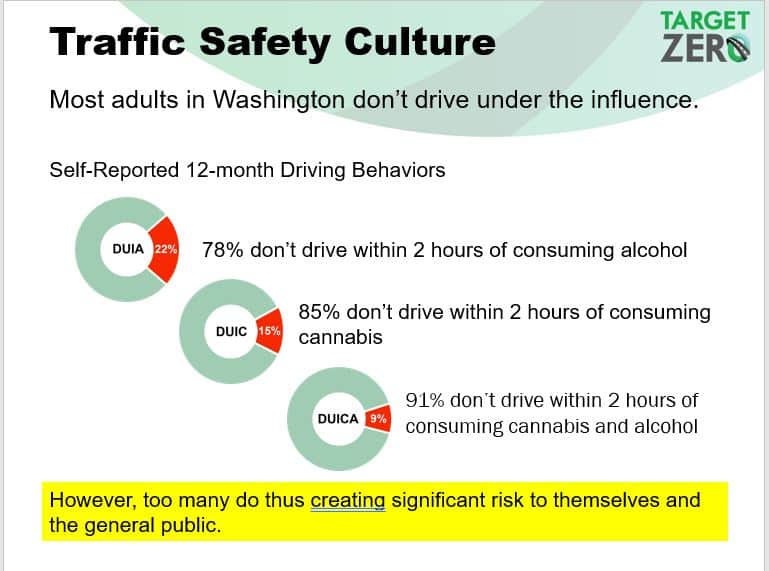Traffic Safety Conversations with Cannabis Users at Budfest
Attendees of Bellingham’s first Budfest, billed as a celebration of “cannabis culture” in Whatcom County, probably didn’t expect to sit down and talk about marijuana and safe driving. But that’s exactly what many of them did with Region 11 Target Zero Manager Doug Dahl.

“I was really pleased with how many people engaged and wanted to have conversations about being a responsible cannabis user,” Doug says.
With a booth next to one for a bong shop, Doug displayed posters he made from the University of Montana’s research, commissioned by the Washington Traffic Safety Commission, about driving under the influence of cannabis and alcohol (DUI-CA). “I set the posters up in a semicircle and put stools in the middle so people could just come in and sit down and look it all the information.”
Doug was surprised at the positive response he got.
“I’ve done a good number of fairs, and I’ve always tried to have a game or something fun to engage people. So, I felt a little uncomfortable going into this with just information and only stools for people to sit down. There were no gimmicks. But it was an effective way to engage people in conversations because they actually want to talk.”
The information Doug presented struck a chord with Budfest attendees. “Overall they had a really positive attitude towards safety when it came to cannabis use and driving. They shared their own behaviors, saying ‘if I use cannabis, I just don’t drive that day,’ or however long it was a concern for them. Or they shared a story about a time they drove impaired or got a DUI and how it changed their behavior.”

Doug found that sharing information through a framework of positive community norms was effective. “One of the models they use in positive community norms is balancing hope and concern. And so, I used some of the results from the University of Montana study talking about the risk factors of driving under the influence of cannabis and alcohol. And the hope was seeing such positive values from Washington drivers around not driving after consuming anything, and being willing to intervene, and trying to do something.”
Doug found that visitors to his booth responded positively, especially to the information around bystander interventions. According the University of Montana’s research, among adults in Washington who are in a situation with a DUI-CA impaired driver, most (81 percent) intervene.
“The research on bystanders seemed like it was really an encouraging thing for people. They told me how they feel they should intervene, and the idea that most people do intervene seemed to give them more confidence to act when needed.”
The organizers of Budfest supported the traffic safety message and, in fact, had invited Doug to attend and provided the booth space for free. “I regularly attend a community meeting that involves bar owners, cannabis stores, and law enforcement, and I met the organizers there. They want this kind of partnership, and recognize the need to promote safety, and for having responsible cannabis users.”
Not only was the desire for responsible cannabis use shared by festival attendees, Doug also found attending provided positive reinforcement for the role he can play in delivering Target Zero’s message.
“Sometimes when you’re in any field for a while and you immerse yourself in information, it all becomes obvious to you. And all this stuff that anyone who’s working for the Traffic Safety Commission knows by heart, is still new information for a lot of people in the community. And they want to know it. So, I think we have more to share than we sometimes think we do.”
###



